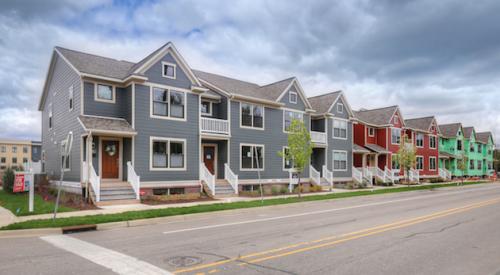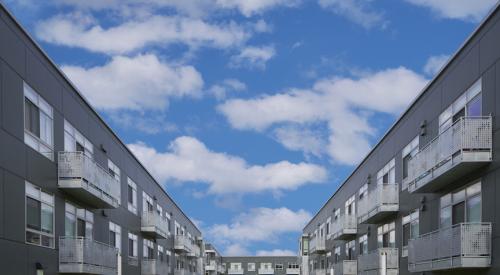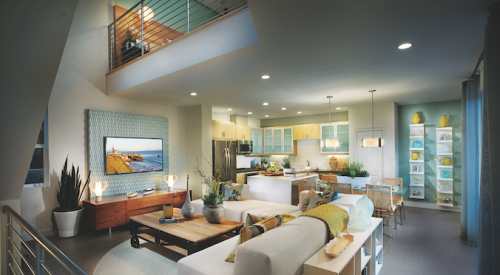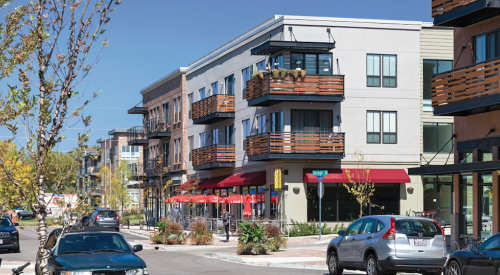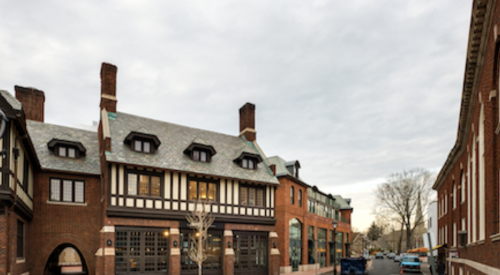| Phoenix’s central business district (opposite page) provides a backdrop from the balcony of a townhome model. The urban location and slick interior finishes draw “young, white-collar professionals,” Post Properties’ Dallas-based Jim Sibley says. |
Fifty years ago, before the rise of Scottsdale and other eventual boomburbs that surround Phoenix, this neighborhood was near the edge. Its slew of single-story, craftsman homes along several city blocks with alleys was one of the last stops before miles of open desert. Today, many of those homes are still here. So, too, is the Tuscan-style Episcopal basilica with its adjoining bishop’s residence. Newer to the neighborhood are America West Arena, museums, a public library, shops and restaurants.
Enter Post Properties Inc., the Atlanta-based REIT (real estate investment trust) and noted builder/developer of mixed-use luxury apartment communities. It manages 32,741 apartments in 95 communities around the country, with 4,121 apartments under construction. Two years ago, with tax incentives provided by local authorities, Post began construction on Roosevelt Square Apartments, an amenity-laden, 403-unit, four-story structure with 30,000 square feet of retail on the first level.
More recently, on an adjoining parcel, the company’s home building operation, Armada Homes, came out of the ground with a for-sale product, the first phase of 17 townhouses. Two models for the Townhomes at Roosevelt Square opened July 10 with "very good response" from a wide array of Phoenicians, says Jim Sibley, a Dallas-based Post executive who was on hand that day.
"There is a broader profile than I expected," says Sibley. "Everybody had to see it to believe it. Infill vertical living is a new and different product for the Phoenix market. For some people it takes a close look to understand what we are doing."
| An inviting pedestrian vista fronts the first phase of the Townhomes at Roosevelt Square, where designer David Pierce of Pierce Goll Architects in Dallas employed trellises, barrel-tile roofs and portico elements to add shadow and interest to the sheer face of the façade. |
Newness of product aside, things have gone well in the early going, says Jill Starmer, a Scottsdale-based Realtor with RE/MAX Fine Properties who is handling sales for Armada. Two units are in escrow. Not bad considering that prices start at $300,000 and go up to $450,000 for 1,900 to 2,800 square feet of living space. Starmer predicts there will be no shortage of target buyers. Sibley describes that group as similar to the "25- to 37-year-old, white-collar professionals" to whom Post caters its rental properties with health clubs, pools and concierge service. Townhome buyers will enjoy the same access to these amenities as the "renters by choice" across the street. Post also anticipates some dual-income couples with no children, empty nesters and singles.
"In Dallas (where Post built a similar product) we got a lot of empty nesters that wanted to be close to cultural events," says John Allums, an executive vice president with Post. "I also think people are tired of the driving and long commutes."
Wherever Post goes, whether it’s Dallas, Denver, Atlanta, Charlotte, N.C., or in this case Phoenix, the company usually carves out room for a for-sale component, Allums says. The purpose is to benefit the larger community around it as "a neighborhood enhancement and to bring stability." For-sale townhomes also help provide a smooth transition between the current owner-occupied neighborhood and a more intense midrise apartment use. Otherwise, says Allums, Post would probably not be in the home building business. That is also why the company recently initiated a policy of shedding its for-sale parcels in favor of partnerships with outside builder/developers.
"Home building is not a high-volume business for us," Allums says. "Our main focus is high-quality, luxury, urban, for-rent product."
In the future, whether the company builds on an infill site or develops a new town center for a suburban area, Post will continue to make room for for-sale sections, Allums says, but someone else will build them.
Streetwise
The seven units in the first phase do not turn their backs on the street, creating the fortresslike effect found among many of the urban townhomes built during the 1980s and ’90s. Instead, the Townhomes at Roosevelt Square - like most urban projects today - embrace the street. Here, the units wrap around a city-block corner, flush against brick-paved sidewalks lined with parkway palm trees. Together with the sidewalks and trees, the townhomes forge an inviting pedestrian vista.
"In urban work, it is important to the definition of the street that the façade be regular and intact," says the project’s designer, David Pierce of Pierce Goll Architects in Dallas. "Consequently, the depth that you are left to manipulate for visual interest is relatively shallow, and rightly so."
Drawing on traditional Southwestern themes but not mimicking them, Pierce used wooden trellises, barrel-tile roofs and little doorway porticos that project out, ever so slightly, from the façade to provide shadow and interest. Space for large potted plants on either side of the front stoops add to a grander entry effect. The tops of the porticos add small, second-floor balconies with gardening space.
Other iterations along the street include subtle changes in the massing of the exterior entries. Beneath the barrel-tile roof portions of the building, Pierce created large square sections in the façade and recessed them a few inches to create visual interest on the shallow, street-facing elevation.
"We played some games with the control joints in the exterior veneer to accentuate the individuality of the units," says Pierce, "but also to overlay some proportioning systems back onto the units."
Two-car garages are accessed only through an interior parking court. Visitors enter from the street, making the units ideal "for a sole practitioner" who wants to operate a business at home, Sibley says. Although the units are technically not part of the celebrated live/work movement in urban design, they do have the city’s blessing for small signage at street level.
Two other options for the first-floor office/study are a grand foyer leading to the second-floor living space, or a third bedroom. In reality, only the corner units would be suitable for an additional first-floor bedroom, as they are the only units with bathrooms at that level.
Connected Living
| Stainless steel appliances, slate countertops and hardwood floors are musts for urban home shoppers, even if cooking is not a daily event anymore. |
Up the stairwell from the first floor, the living space is open with plenty of natural light. This is where Post’s experience with young professionals stands out. There are fewer decorative trim elements and built-ins than usual in new townhome models at this price point. More in keeping with the target buyer and the price point, the finishes (slate countertops), flooring (hardwood) and doors (solid alder) are first-rate. So, too, are the homes’ wiring systems and appliances.
High-speed Internet connections are available in every room. Audio/video wiring also enables quick installation of standard or elaborate home entertainment systems.
On the third floor, 9-foot ceilings lend the master suite and second bedroom an airier, loftlike feeling. Also significant is an upstairs laundry room that abuts a large master bath. The focus seems tilted toward large rooms, uncomplicated floor plans and quality fixtures as standard options.
| The master bath is small, but the design still manages to find room for a tub, a shower stall and a private toilet. |
Taken together with a newly vibrant downtown neighborhood, the townhomes offer a solid live/ work/play environment where buyers will feel inclined to put down roots. And that, Pierce says, is the main goal.
"The danger in this kind of urban resurgence is that too much of it becomes rental-based, that there is not the investment by the people living there in the place as a neighborhood," says Pierce. "The people who are buying these are investing in a way of life different from what has been traditional in the last 40 or 50 years. This used to be the way that much of urban America lived. And in the past five years, we’ve rediscovered it."
Also See
Urban Pioneers
Lofty Ambitions
Cleveland Renaissance

